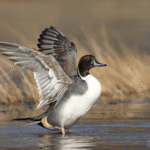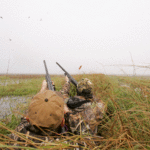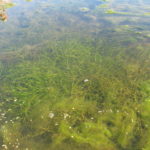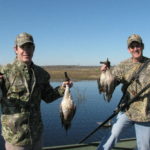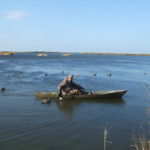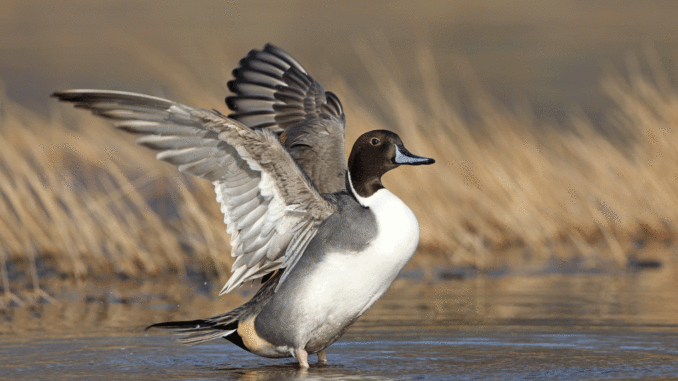
Tides come and tides go, and they have a tremendous influence on the precise location of feeding ducks.
The Saints had just squeaked by Atlanta to clinch the wild-card playoff spot, and (not suspecting how Seattle would upset them during the play-off game) we were seriously pumped as we strolled outside onto Doc’s gazebo.
For most people, it looked like ideal “duck weather” — but Artie was worried as he looked around.
“Man, with all this north wind, we ain’t gonna have no waaaw-da,” he said, pointing at the swaying branches. “Tomorrow we gonna have mudflats rather than ponds.
“Don’t forget the push poles.”
“Look again, Artie,” Pelayo advised as he popped open a brewskie then pointed at the furiously flapping Saints flag atop Doc’s shed. “The wind’s howling alright, but it’s howling slightly from the northEAST — as it’s been doing for the past two days.
“You know how that works on tides on the east side of the river. And Doc’s new property is around Pointe-a-la-Hache. Heck, we might have too much waaaw-da.”
“Don’t think so,” Artie replied. “Eddie hunted his ex brother-in-law’s lease at Cae-naaaw-von on Wednesday.
“He said the waaaw-da was real low.”
Chris nodded as he bit into one of Trisha’s famous crab-stuffed mushrooms.
“But remember, waaaw-da levels ain’t a big deal where Eddie hunts in Cae-naaaw-von. His new surface-drive boat plows through anything… And man!” Chris said chewing and nodding. “Trisha outdid herself with these stuffed mushrooms! Nice and heavy on the gaaaw-lic! No wonder they’re going even faster than Pelayo’s Button Buck Fajitas!”
In fact we all knew that before the night was out, Artie would be bugging out of the morning’s hunt with some excuse. On duck hunting, Artie’s one of these guys who sure talks a good one. You know the type: DU banquets, duck-calling contests — they hit ‘em all. They own every trinket from mojo decoys to a $50 duck call. Closet’s crammed with six different types of marsh and cattail camo. You see him around Thanksgiving.
“Hey Artie, you been getting some ducks?”
“Naw, man. Ain’t been cold enough to push ’em down. Waaaw-da’s too high at my lease, anyway. The few ducks around are scattered all back up in the marsh. Gotta kill yourself getting to ‘em. I’m waiting for a few good fronts.”
Then you see him around New Year’s.
“Hey Artie, must be wearin’ em out at your lease NOW, huh? Plenty fronts barreling through!”
“Naw, man. My ponds ain’t got no waaaw-da! Damn fronts blew it all out. Gotta kill yourself push-poling to get to the damn blinds. I’m gonna wait ’til it comes up a little.”
Next year: “You been gettin’ em, Artie?”
“Naw man, ain’t been out yet. Ain’t got no feed in my ponds. Salt waaaw-da from the tropical storm killed it all.”
Now the following year with no tropical storms.
“Plenty ducks this year huh, Artie?”
“Naw, man. Dem big bays are all choked up with grass from the fresh waaaw-da from the spillway opening. Dem ducks got so much feed dey staying out in the open waaaw-da. Ain’t coming in my ponds. Can’t get ‘em to work the decoys.”
I love listening to Artie, really.
But he’s got a point. In tidal marshes ducks are notoriously nomadic and fickle. Sure, all ducks, regardless of habitat, respond to hunting pressure. On top of that, in the tidal marshes, we’ve got those fickle water levels that send ducks scooting away from, or swarming into, certain regions from week to week — heck from day to day!
Usually we actually scout more for duck hunting than for deer hunting. Sounds crazy, I know. But it’s the only way to assure consistently good hunting in tidal marshes. Alas, “gypsy hunting” (scouting and moving around) looked out of the question at Doc’s new lease with its comfy permanent blinds. So we’d have to slum it up.
In the southeast marshes, a five-degree shift in the wind from north to just slightly northeast (or vice versa) can mean a 10-inch tidal change in two days. An area crammed with greys and teal during your scouting trip might have two mergansers and three dos gris when you come back. The high tides put the milfoil, coontail and widgeon grass out of beak range.
Then another front barrels through, and the greys pour back in. This on top of the regular daily tidal ranges. We check Louisiana Sportsman’s tide guides as fanatically for duck hunting as for fishing.
It used to baffle us. How can the greys go on a flying and feeding frenzy during a vicious front when we’re hunting Lafitte, Hopedale or Delacroix while disappearing from the skies over the duck potato flats in the delta? Then they go into a similar frenzy in the delta with those balmy southeast gales three days after a front?
Tides, that’s why. The tidal fluctuations in the delta marshes (Mississippi and Atchafalaya) are simply a fast-forward version of what happens throughout the brackish tidal marshes. High tides, and the puddlers swarm into the flooded shallows to feed. It’s the perfect depth. Low tide, and they raft out on the open deeper water.
The whole early season/late season debate of years past used to center around tides. In the southeast, we claim we can’t hunt late because of the fronts. They blow out all the water. And yes they do — but primarily out of the upper, fresher marshes. The ponds and bays in the lower, more brackish marshes are then reduced to 10 inches or so. The dwarf spikerush and widgeon grass then come into beak range — and the ducks swarm in. In the deltas, the puddle ducks shift from scooping up wild millet and duck potato seeds during teal season to rooting in the mud flats for duck potato tubers in December and January.
Fact is, usually there are more ducks down in our southeast marshes in December and January than in November. But in different places. So normally we move with the ducks. We follow them, and often get the hottest shooting of the year as a result.
Dabbling ducks (pintail, greys, widgeon, teal, mallards) like it shallow, usually a foot or less. Here they can tip up with their butts in the air to reach the seeds, grasses and assorted muck from the bottom. Greys and widgeon swarm into deeper ponds in the brackish marshes, but that’s usually if the milfoil is matting on the surface or the widgeon grass is bunching up around the edges.
“They were sure here LAST week,” Pelayo lamented as we paddled up to Doc’s new blinds elegantly late, as usual for us. Artie and Doc dropped us off with the ‘rogues from the bay boat and went fishing. They’d pick us up at 10:30. Pelayo was right. Our paddles went most of the way down before they hit bottom. The water was up, and the ducks were elsewhere.
The previous week, our paddles had hit bottom at less than a foot. The push-poles had come in handy — but ducks had lifted by the dozens upon our approach, setting our pulses racing. And limits had come quickly.
An hour in the blind on this morning, and we had one grey and one teal to show for it, a tiny fraction of the ducks we’d seen near us. The suicidal greenwing had decoyed. But the grey had been a wild (and lucky) pass shot by Pelayo. He was getting desperate and tired of seeing all the ducks snubbing us after a pass or two. The ducks (mostly greys and teal, a few pintail) were around alright, but not working our decoys whatsoever.
An area about 300 yards away on the edge of Doc’s property was attracting them, drawing them away from us. We kept looking at the area then at each other. We both knew what was coming. Pelayo was first out of the blind.
“OK,” he nodded. “Let’s get over there. Time’s a-wasting.”
And off we went. But first we picked up 10 decoys.
As we paddled, more ducks kept descending near our destination. We paddled furiously against the wind for about 300 yards. Being downwind from the duck action meant the glorious gabble soon hit our ears — chuckling, gabbling, quacking, a few widgeon whistles, even what sounded like pintail whistles, rare for this area. Luckily, the high tide allowed us to glide easily through a scrawny trenasse toward the action.
A pair of greys drifted overhead, and we stopped to gawk. They were a couple, drake and hen. They were already pairing up. They cupped while directly over, banked and set a gliding course for the feast and orgy raging up ahead. Then some greenwings buzzed over, and quickly plunked into the duck gathering.
I was panting by now — but not from the exertion. The gabble was on high volume as four greys cupped overhead and started dropping into the orgy. But they must have seen the glint from my glasses. Ten yards from landing, they flapped off frantically, quacking as they turned on the afterburners. That was the signal.
At least a hundred ducks promptly took wing. The sight and sounds were glorious. As usual, they quickly split up by species. A pair of pintail split first. Their profiles were unmistakable — slender, elegant. The greys and a few widgeon started splitting up next. The teal, as usual, buzzed around like fat shorebirds, seemingly undecided on where to go.
We kept paddling, and got a glimpse at the place that attracted them. It was a huge eroded area — either from nutrias or high saltwater tides — that stretched for about a hundred square yards. This combination of erosion, eat-out and a blustery northeast wind had created an open area of weedy, seedy marsh with that perfect 10 inches or so depth for puddlers. The high tides had also blown in some widgeon grass that Pelayo raised with his paddle. The place was perfect.
The ’rogue was scraping bottom as we chunked out the 10 dekes.
“Could be hell gettin’ outta here,” Pelayo frowned. “Hope the tide doesn’t fall anymore.”
“I think this northeast wind might save us from that,” I said, only semi-convinced.
We jammed the ’rogue into some bachiris bushes, and gave a few quacks and whistles. Six greenwings buzzed in immediately, circled once, and plopped in the dekes. A pair of bluewings followed. And we opened up just as they touched down. Both stayed with us, along with a slow greenwing.
Off to my right, I caught movement — pintail, no mistaking them. Pelayo was pointing to his left and hunkering down as another flock of greenwings blazed our way.
There’s no mistaking pintail in flight. Those long wings and sleek profiles could only belong to the prince of wildfowl — his majesty, indeed. And here was a whole flock. Young ones no doubt — young and stupid. Good.
Two toots from Pelayo’s whistle, and they’d locked in on the decoys. In seconds, those long, slim wings, more reminiscent of shorebirds or gulls than ducks, were barely flapping. They started cupping. Those longs necks were craning back and forth. But at 70 yards, the three in the lead started veering off.
My own pintail whistle came up, and I tooted softly — twitting my tongue against the roof of my mouth. Pelayo kept up his tooting — then added a quick hail and a few chuckles. It worked. They swung back on course. Their wings started gliding again, barely moving … the landing gear started to go down, but they were still 50 yards out. A little too far. Still a dizzying sight. Pintail landing, actually LANDING! Doesn’t happen very often (except during teal season, of course).
Then a jet-like roar of wings came from behind, and a flock of greenwings rushed in over the bachiris grove, practically knocking off our caps. They swerved just in front of the pintail, blazed out into the opening and started turning back. Pelayo and I looked at each other trying to stifle guffaws. But it was shooting time. Four of the pintail had hovered a bit closer. They glided over the decoys.
We rose.
BLAM! BLAM! BLAM!! Three shots, and two big drakes crumpled. A third staggered off to my left. I followed him with the bead, lead him about 2 feet and touched the trigger — BLAM! His neck sagged, and he splashed down, clobbering the farthest decoy. We stood there admiring the carnage and high-fiving.
“Get low!” Pelayo suddenly rasped as he ducked, jammed down his cap and fumbled for shells. “And hide your face!”
What a sight. More ducks were winging in, cupping up, swerving slightly while slowing down. Forty years of it, and the sight still unhinges us. Must be because for some hunting’s not a hobby. It’s not a pastime — it’s an instinct.
“Man’s being consisted first of being a hunter,” tells us philosopher Jose Ortega y Gasset.
“Man evolved as a hunter,” says Chicago University anthropologist W.S. Laughlin. “He spent over 99 percent of his species’ history as a hunter, and he spread over the entire habitable globe as a hunter.”
These four were high. The kind that appear WAY up there but with the slow wingbeat and craning neck movement that signal ducks looking for company. Ducks that might decoy.
Sure enough. At Pelayo’s first hail, the greys slowed and banked. I chimed in with more quacks and whistles, and they cupped. Down they came. Almost STRAIGHT down. It was amazing. Cupped wings are one thing. These cupped their wings in almost to the body for a rapid descent. Usually you start calling at ducks at that altitude, and they’ll circle three or four times. Not these. These were probably here earlier. They were probably among those we spooked. They wanted back in now. We watched the wind rustling their wing feathers, and what a heavenly sound. In seconds they were almost on top of us.
My heart was in my throat as we rose to greet them at point-blank range.
BLAM!!
Pelayo beat me to the draw, and I saw one fold on the left. BLAM! BLAM!! Our next shots went off almost as one, and two more cartwheeled into the dekes. I was drawing a bead on the last one, but held off. He looked out of range.
We didn’t quite limit out, but came close: 9 ducks in an hour and a half. A few inches of tide (hence food availability) had caused the shift in duck flyways (and duck landways) at Doc’s lease.
